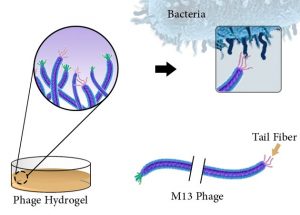Antibacterial phage hydrogels

Tech ID
20-011
Inventors
Z. Hosseinidoust
Patent Status
U.S. and Canada applications filed
Stage of Research
Proof of principle data is available
Publications
Contact
Amy Hector
Business Development Manager
Abstract
Bacteriophages (also known as phages) are viruses that specifically fight bacteria in nature, without affecting non-bacteria cells. Bacteriophages have been used for over 100 years in clinics around the world to treat bacterial infections. With the rise of superbugs, phages have garnered more attention as a targeted approach to fight antimicrobial resistant bacteria. Phages have been developed as structural material for developing coatings and gels, but the focus has so far never been on their antimicrobial property, but rather their identity as protein nanoparticles. Therefore, no effort was made to preserve phage antimicrobial activity when it was used as structural material.
Fortunately, McMaster researchers have created hierarchically structured hydrogels composed entirely of self-organized phage. These phage hydrogels retain the innate antimicrobial activity of free phage and in addition, they can return to its original state after being cut or sheared with minimal scarring (self-healing). These bioactive hydrogels also biodegrade and emit fluorescence, allowing non-destructive imaging. These simple and versatile hydrogel compositions can be utilized within a plethora of medical and environmental applications.
Applications
Medical applications:
- Antibacterial wound dressings
- Antibacterial coatings on healthcare surfaces
- Antibacterial sutures for surgical wounds
- Antibacterial injectable hydrogel for grafts and implants
Environmental Applications:
- Filtration of contaminants from drinking water and soil
Engineering Applications:
- Materials engineering (e.g. deposition and catalysis)
Advantages
- Targeted antimicrobial activity (kills only specific bacteria)
- The hydrogels biodegrade in the body
- Bioactivity includes antibacterial activity, self-healing, and autofluorescence
- Soft and hydrated gel properties are similar to human tissue
- Can naturally target and kill specific bacteria strains
- Can be genetically engineered to target specific tissues and/or cells (e.g. tumours), materials (e.g. plastics, metals, minerals) or small molecules (e.g. ions)
News/Media


